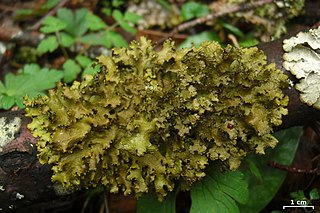
Parmelia is a genus of medium to large foliose (leafy) lichens. It has a global distribution, extending from the Arctic to the Antarctic continent but concentrated in temperate regions. There are about 40 species in Parmelia. In recent decades, the once large genus Parmelia has been divided into a number of smaller genera according to thallus morphology and phylogenetic relatedness.

The Parmeliaceae is a large and diverse family of Lecanoromycetes. With over 2700 species in 71 genera, it is the largest family of lichen-forming fungi. The most speciose genera in the family are the well-known groups: Xanthoparmelia, Usnea, Parmotrema, and Hypotrachyna.

Cetraria is a genus of fruticose lichens that associate with green algae as photobionts. Most species are found at high latitudes, occurring on sand or heath, and are characterised by their "strap-like" form with spiny lobe edges. The lobes can range from narrow and linear to broader and flattened, often forming loose or densely packed cushions. Their distinctive spiny margins serve both a defensive role and aid in vegetative reproduction through fragmentation. The genus was created by Erik Acharius in 1803 and belongs to the large family Parmeliaceae. While originally a species-rich genus, taxonomic revisions since the 1960s have split many species into new genera, though the exact circumscription remains debated among lichenologists.

Ahtiana is a fungal genus in the family Parmeliaceae. A monotypic genus, it contains the single species Ahtiana sphaerosporella, the mountain candlewax lichen, found in western North America. The species was originally classified as Parmelia sphaerosporella by Johannes Müller Argoviensis in 1891, before Trevor Goward established the new genus Ahtiana in 1985, naming it after Finnish lichenologist Teuvo Ahti. This foliose lichen is characterised by its pale yellowish-green thallus, spherical spores, laminal apothecia, and the presence of usnic and caperatic acids. It primarily grows on the bark of whitebark pine in subalpine and montane regions, though it occasionally colonises other conifers outside its preferred host's range.

Allocetraria is a genus of lichenized fungi in the family Parmeliaceae. It consists of 12 species, with a center of distribution in China.

Arctocetraria is a genus of fruticose lichens in the family Parmeliaceae. It has three species.

Cetrariella is a genus of foliose lichens in the family Parmeliaceae. It contains three species.

Vulpicida is a genus of lichenized fungi in the family Parmeliaceae. Circumscribed in 1993 to contain species formerly placed in Cetraria, the genus is widespread in Arctic to northern temperate regions, and contains six species. The genus is characterized by the presence of the secondary metabolites pulvinic acid and vulpinic acid, compounds that when combined with usnic acid, give the species their characteristic yellow and green colors.

Tuckermannopsis is a genus of foliose lichens in the family Parmeliaceae.

Cetrelia is a genus of leafy lichens in the large family Parmeliaceae. They are commonly known as sea-storm lichens, alluding to the wavy appearance of their lobes. The name of the genus, circumscribed in 1968 by the husband and wife lichenologists William and Chicita Culberson, alludes to the former placement of these species in the genera Cetraria and Parmelia.
Everniopsis is a fungal genus in the family Parmeliaceae. It consists of a single species, the bark-dwelling lichen Everniopsis trulla, which occurs in Africa and South America.
Coelopogon is a genus of lichen-forming fungi in the family Parmeliaceae. The genus contains two species found in southern South America and South Africa.

Esslingeriana is a fungal genus in the family Parmeliaceae. The genus is monotypic, containing the single foliose lichen species Esslingeriana idahoensis, commonly known as the tinted rag lichen. It is found in northwestern North America.

Usnocetraria is a small genus of lichen-forming fungi in the family Parmeliaceae. It contains two species of corticolous (bark-dwelling), foliose lichens.

Tuckermannopsis orbata, commonly known as the variable wrinkle lichen, is a species of foliose lichen in the family Parmeliaceae. It is a small cetrarioid lichen, an informal growth form category that denotes lichens with erect, foliose thalli, and apothecia and pycnidia on the margins of the ruffled lobes. Tuckermannopsis orbata is found in Asia and North America, growing primarily on the wood and bark of mostly birch and coniferous tree branches and twigs.

Tuckermannopsis ciliaris is a species of corticolous (bark-dwelling), foliose lichen in the family Parmeliaceae. It was first described by Erik Acharius in 1810, initially classified in the genus Cetraria. The species was later reclassified into the genera Nephromopsis and then Tuckermannopsis, with some researchers proposing that certain cetrarioid genera, including Tuckermannopsis, should be merged into Nephromopsis. However, this suggestion was disputed, and both names, Tuckermannopsis ciliaris and Nephromopsis ciliaris, are used in recent literature to refer to this species.

Cetraria arenaria, commonly known as the sand-loving Iceland lichen, is a species of terricolous (ground-dwelling), fruticose lichen in the family Parmeliaceae. It was formally described as a new species in 1977 by the Norwegian lichenologist Ingvar Kärnefelt. The type specimen was collected in 1949 by Henry Imshaug from Mackinac County, Michigan, where he found it growing on sandy soil.

Usnocetraria oakesiana, commonly known as the yellow ribbon lichen, or the yellow-green ribbon lichen, is a species of corticolous (bark-dwelling), foliose lichen in the family Parmeliaceae. It occurs in Asia, Europe, the north-eastern United States, and eastern Canada.

Vulpicida canadensis, the brown-eyed sunshine lichen, is a species of foliose lichen in the family Parmeliaceae. It is endemic to northwestern North America where it grows as an epiphyte on the bark and wood of conifer trees.
Cetraria peruviana is a rare species of fruticose lichen in the family Parmeliaceae. It is known from a single collection in a high-elevation locale in Cusco, Peru.















